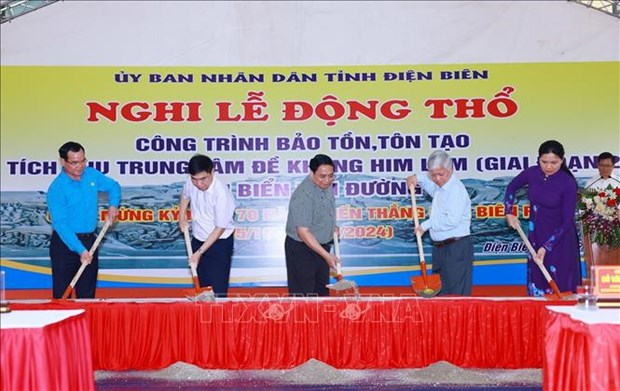 Features
Features
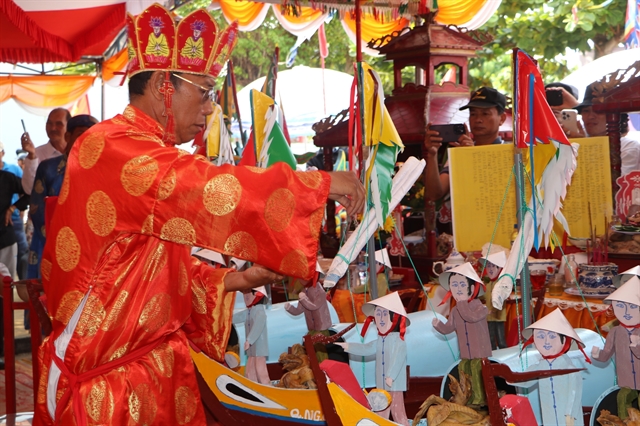
Last year’s historic drought devastated crops and caused serious losses for farmers in the Mekong Delta. This year, authorities are restructuring crops, building dykes and erecting sluices in anticipation of continued weather changes.
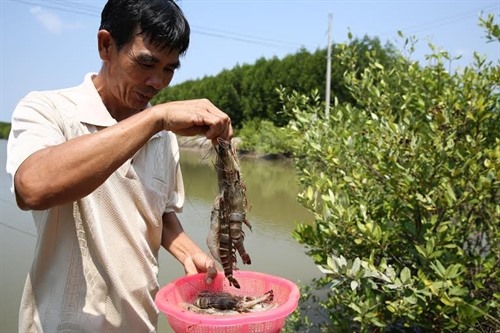 |
| New initiative: Local residents collect products from the mangrove-shrimp model project. — VNS Photo Hoàng Nam. |
Last year’s drought devastated crops and caused serious losses for farmers in the Mekong Delta. This year, authorities are restructuring crops, building dykes and erecting sluices in anticipation of continuing weather disasters.
By Phạm Hoàng Nam
The official attitude of provincial authorities in the Mekong Delta region this year could be deemed “forewarned is forearmed”.
Authorities are determined to prevent a recurrence of the disaster that struck last year after the worst drought in 90 years, along with serious saline intrusion, affected the entire region.
This year, the Delta is storing as much fresh water as possible. Dykes have been upgraded, sluices erected, and crops restructured. Master plans on climate-change adaptation are being reviewed and adjusted.
Predictions are that saline intrusion will be at a higher level this year in comparison with previous years. But it will be lower and less serious than last year, according to the Ministry of Agriculture and Rural Development’s Irrigation General Department.
Salty water is already beginning to enter the Delta and will increase by early March.
Kiên Giang Province in the southwestern area of the Delta has taken precautionary measures by investing more than VNĐ40 billion (US$1.8 million) to upgrade 276 dykes and build sluices on the Kiên River and Cụt Canal.
Another VNĐ20 billion ($900,000) has been spent on drilling more wells to ensure fresh water for domestic use.
The province has also worked closely with the neighbouring province of An Giang on “a proper plan to use water resources”, according to Nguyễn Văn Tâm, the director of Kiên Giang’s Agriculture and Rural Development Department.
Authorities have made careful plans for the winter-autumn crop, based on the availability of water resources in different localities.
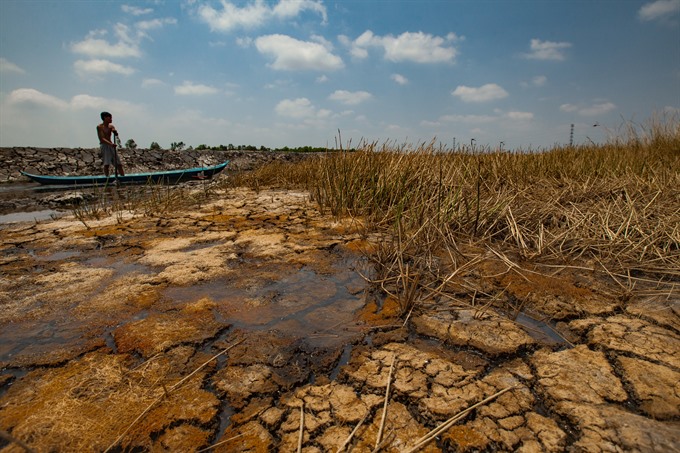 |
| Natural disaster: Việt Nam’s worst drought in 90 years destroyed many crops in the Mekong Delta last year. - VNS Photo Nguyễn Luân |
In Bạc Liêu Province, hot weather and salinity have been occurring since early February.
The province, working with the neighbouring provinces of Cà Mau and Sóc Trăng, is now operating 100 major sluices to adjust the usage level of fresh water.
More than 40 temporary dykes have been built, and farmers have been warned to preserve fresh water.
In an attempt to prevent saline intrustion and preserve soil quality, the entire region has also reduced the number of rice crops planted from three to two each year. The extra time will be used for vegetable cultivation.
Tiền Giang in the coastal region, for example, has already shifted 2,500 hectares of land to vegetable cultivation.
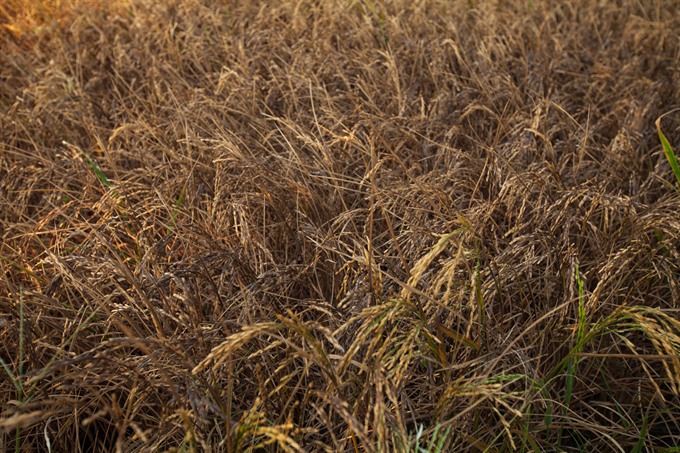 |
| Climate change: Rice ruined by drought. - VNS Photo Nguyễn Luân |
Master plan
Opinions about a master plan for the Delta to cope with climate change vary among experts, but all agree that it must be adjusted and completed as soon as possible.
Dr Tăng Đức Thắng of the Southern Institute of Water Resource Research said: “The Delta needs a long-term master plan to cope with drought and salinity, as it is one of several places in the world that will suffer the most from climate change.”
This year, the amount of fresh water in the Mekong River is estimated to be 15-35 per cent lower in comparison with previous years, according to a report from the General Department of Irrigation.
“Water-related development in the Mekong upstream has already affected agricultural production and daily life, and it will have a more serious impact in the future,” Thắng said.
“The government should give priority to investing in salinity-control sluices along the Tiền and Hậu rivers and modernising irrigation by using automatic measurements and connecting independent irrigation systems to a larger system,” he added.
To cope with changes in weather, the Ministry of Agriculture and Rural Development has made a 2016-20 action plan, which links agricultural production and rural development in the Mekong Delta.
Under the plan, rice is now mainly cultivated in the Đồng Tháp Mười (Plain of Reeds) sub-region, which includes the provinces of Long An, Đồng Tháp and Tiền Giang.
Coconuts and pomelos are grown in a sub-region traversed by the Tiền and Hậu rivers in the provinces of Tiền Giang, Vĩnh Long, Trà Vinh and Bến Tre. And shrimp are farmed mostly in the sub-region of the Cà Mau peninsula, which includes Sóc Trăng, Cà Mau, Bạc Liêu and Kiên Giang provinces.
As part of the plan, rice and catfish are now the major products in the sub-region of Long Xuyên, which includes the provinces of Hậu Giang, An Giang, Cần Thơ and Kiên Giang.
 |
| Green growth: A mangrove-shrimp model in Cà Mau province. -- VNS Photo Hoàng Nam |
Trần Công Thắng, deputy head of the Institute of Policy and Strategy for Agriculture and Rural Development, said that while the government had taken action to cope with climate change, more solutions were needed.
“Việt Nam has built more irrigation dykes and sluices, enhanced measurements and warnings, provided more financial and technical support, changed timetables for crop farming, shifted farm lland from rice to vegetables, and planted new rice seeds resilient to drought and salinity,” he said.
“But all of these measures have limitations and we still lack long-term, sustainable solutions for the region,” he added.
However, Dr Andrew Wyatt, the Mekong Delta programme manager at the International Union for Conservation of Nature (IUCN) Việt Nam, told Việt Nam News that the Mekong Delta Plan had already covered many of the most pressing issues.
The plan was created in 2013 by Việt Nam and the Netherlands under a Strategic Partnership Arrangement on Climate-Change Adaptation and Water Management.
“The Mekong Delta Plan has carefully noted all of the climate-change impacts that would affect the region over the long term, and all suggestions have been properly given under the 100-year plan,” Wyatt said.
The master plan is currently being reviewed and adjustments will be made, according to Wyatt.
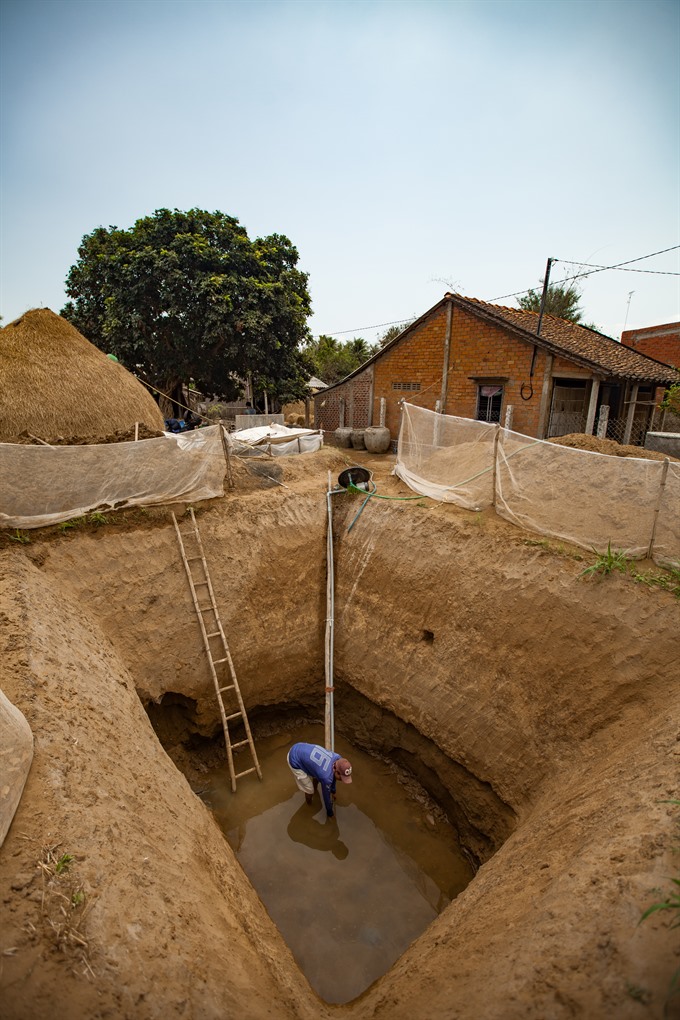 |
| Lack of water: Local residents dig a deep hole to find fresh water. - VNS Photo Nguyễn Luân |
Salinity: friend or foe?
“I think Vietnamese authorities and local communities should change their views and consider salinity as an opportunity to develop in a new way,” Wyatt said, adding that agricultural practices could be shifted to take advantage of saline conditions.
Before Việt Nam’s reunification in 1975, the Mekong Delta region had no dyke systems to keep fresh water.
“In the past, farmers knew how to cope with salinity, but now, after a long time of being protected, they don’t know how to deal with it,” he added.
Wyatt said that warnings about serious drought and salinity from local authorities to local farmers had been ignored last year.
“Local authorities should provide farmers with useful software that will help them prepare for climate change,” he said.
Over the years, the extensive irrigation system in the delta helped Việt Nam become one of the biggest rice exporters in the world. However, changes to that system have occurred.
“In many places, like the southernmost province of Cà Mau, local farmers destroyed irrigation systems and dykes so they could pump salt water into their shrimp farms," he said. "So now, it’s time to carefully review agricultural production in the region in the context of climate change."
Wyatt also pointed out that in the past, only land in the middle of the Delta region could grow fruit because it was not threatened by flooding or saline intrusion at that time.
“Now, fruit-growing areas have expanded and salinity could affect orchards because fruit needs several years to grow,” he said.
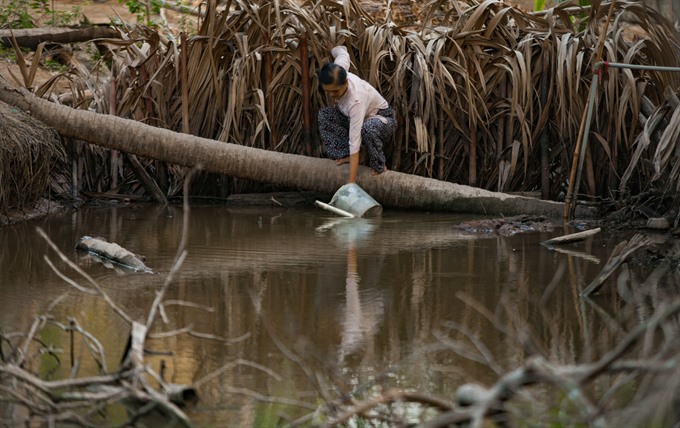 |
| Hard times: Little water was available for daily use last year during the drought. -- VNS Photo Nguyễn Luân |
Mangrove-shrimp farming model
One climate-adaptation project, a new integrated mangrove-shrimp farming model, has been highly successful in the coastal region of the Delta.
Introduced in Cà Mau, it has helped farmers earn more income, while preserving mangrove swamps that aquaculture often destroys.
Many shrimp farmers in the past, for example, cut down mangroves to build ponds for shrimp, which thrive in salty water. This caused coastal erosion and increased saline intrusion in inland farming areas.
The mangrove-shrimp project, organised by the International Union for Conservation of Nature and the Netherlands Development Organisation, was first set up in Cà Mau Province’s Nhưng Mien Protective Forest with 1,075 households.
The project goal is to help local shrimp farmers become more profitable by combining farms with protected mangrove forests, thus increasing profitability and sustainability while also enhancing coastal resilience to climate change.
Although shrimp farming is one of Việt Nam’s leading export-related activities, it is also the leading cause of mangrove loss in a country with a long, densely populated coastline vulnerable to tropical storms and rising sea levels.
The sustainability of the shrimp farming business and the conservation of mangroves are both national priorities.
 |
| Saline solution: New constructions are built to prevent saline intrusion. - VNS Photo Nguyễn Luân |
The mangrove-shrimp project is funded by the German Federal Ministry of the Environment, Nature Conservation and Nuclear Safety.
It focuses on a group of around 2,700 farmers who use an integrated model of farming shrimp in mangrove forests in which each household has to earmark 60 per cent of the land for mangroves.
While farmers may have significantly lower yields per hectare than intensive shrimp farms, the integrated model results in a highly diverse output, lower costs and much lower risk of crop failure.
Not only is this model resilient to disease, but it is also stable and profitable, with incomes significantly higher than from traditional farming.
Households receive training that allows them to acquire certification in raising shrimp without industrial food or chemicals. Farmers also learn how to manage household waste and protect forests.
“With the model, local residents can earn a sustainable living while mangroves are preserved and protect the coast,” Wyatt said.
Underground water is also protected as the mangroves reduce water evaporation.
“If you can protect underground water, you can help stop ground depression, and right now, the Mekong Delta is expected to sink around 10 millimetres each year because of excessive use of underground water,” Wyatt said. VNS








